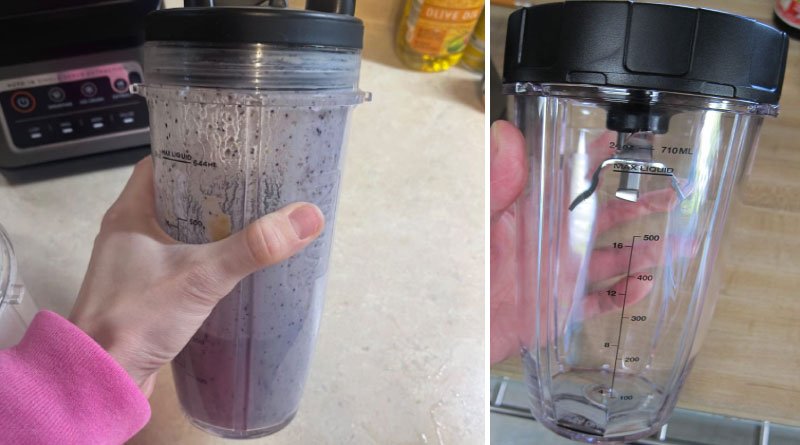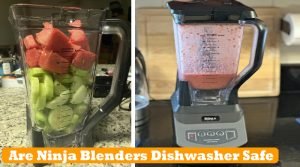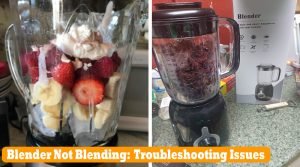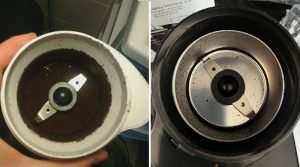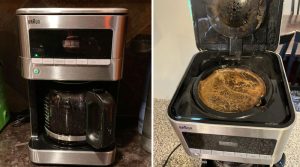How to Clean Ninja Blender Base: Fast and Efficient
Are you looking for cleaning ninja blender base? We’ll walk you through the steps on how to clean Ninja Blender base without causing any damage. Keeping your Ninja Blender base clean is an essential part of maintaining its performance and lifespan. Whether you’re dealing with stubborn stains or just routine cleaning, these tips will ensure your Blender stays in top shape for all your blending needs. A Ninja blender simplifies your food prep and makes delicious smoothies a breeze. It’s crucial to keep this powerful appliance clean, especially the base, to ensure its longevity and efficient performance.
Step-By-Step Guide on How to Clean Ninja Blender Base
Cleaning the Ninja Blender Base is essential for its optimal performance and longevity. The following is a step-by-step guide to help you:
Step 1: Unplug the Blender. For safety reasons, always unplug the Blender before you start cleaning.
Step 2: Remove Detachable Parts Remove any detachable parts, such as the pitcher or cup, lid, and blade assembly. These parts are usually dishwasher-safe and can be cleaned separately.
Step 3: Wipe Down the Base With a damp cloth gently wipe down the exterior of the blender base. Be sure not to let water get into the motor or control panel, as this could cause damage.
Step 4: Clean Hard-to-Reach Areas Use a soft brush (like a toothbrush) to clean hard-to-reach areas where food particles may have gotten stuck. Be gentle to avoid scratching the surface.
Step 5: Use a Mild Cleanser if Necessary. If there are stubborn stains, you can use a mild cleanser. Create a solution with warm water and a few drops of dish soap. Dip your cloth into the solution and wipe the stained area. Then, rinse the cloth and wipe the area again to remove any soap residue.
Step 6: Use a small brush or toothbrush to clean around the buttons and controls gently. If necessary, you can use a little dish soap mixed with water.
Step 7: Dry the Base After cleaning, it’s crucial to dry the base thoroughly. Any moisture left can harm the electrical components. You can air-dry it or wipe it down with a dry cloth.
Step 8: Reassemble the Blender Once all parts are clean and dry, you can reassemble the Blender.
Keep your Blender running smoothly and extend its life with regular maintenance. For specific instructions on cleaning your model, refer to your user manual.
Materials Needed to Clean a Ninja Blender Base
Based on my web search, the materials needed to clean a Ninja Blender base include:
Bar Keepers Friend: This is a popular cleaning product that is often recommended for kitchen surfaces. It can help to remove stubborn stains and grime from the blender base.
Melamine foam (Magic Erasers): This is another effective cleaning tool that can be used to scrub off any dirt or grime from the blender base.
Hydrogen Peroxide: Pour some hydrogen peroxide onto a clean cloth and wipe down the power base.
Toothbrush: A toothbrush is a great tool for cleaning hard-to-reach areas in the blender base, such as crevices and corners.
Dish Soap: With warm water, mix a few drops of dish soap. To remove accumulated dirt or grime from the base, employ a soft brush and scrub gently.
White Vinegar: Ninja blenders are easy to clean with white vinegar. You will need two cups of water and one cup of vinegar for your pitcher. Pulse this cleaning mixture.
Damp Cloth or Sponge: A damp cloth is one of the most basic cleaning tools that you can use to clean the power base of your Ninja blender.
Important of Cleaning Ninja Blender Base
Maintains Hygiene: Regular cleaning helps to prevent the growth of bacteria and mold, which can contaminate your food and cause health issues.
Enhances Performance: Over time, accumulated particles and residues can affect the Blender’s performance. Regular cleaning ensures the Blender operates at its best.
Extends Lifespan: Regular maintenance and cleaning can significantly extend the lifespan of your Blender. It helps prevent wear and tear, saving you from costly replacements or repairs.
Ensures Safety: Keeping your Blender clean reduces the risk of any potential safety hazards that could arise from food particles getting lodged in the Blender’s mechanical parts.
Preserve Aesthetics: Regular cleaning keeps your Blender looking new and shiny, enhancing the overall aesthetics of your kitchen.
Prevents Odors: Leftover food particles can create unpleasant smells over time. Regular cleaning helps keep your Blender smelling fresh.
While cleaning your Ninja Blender base, make sure it’s unplugged and avoid immersing it in water to prevent any electrical damage.
Different Way to Clean Ninja Blender Base
Cleaning a Ninja Blender properly is crucial for its optimal performance and longevity. Based on the search results, here are three different ways to clean a Ninja Blender:
Self-Cleaning Approach
The self-cleaning approach to the Ninja Blender base is a simple and efficient feature that allows you to maintain your Blender in optimal condition. After every use, leftover food particles can stick to the base and blades, which may lead to bacterial growth and unpleasant odors.
 Are you looking for best salt grinder that combines functionality with style and durability? Salt grinder is easy to refill and clean, making it convenient for busy home cooks who seek convenience without sacrificing quality.
Are you looking for best salt grinder that combines functionality with style and durability? Salt grinder is easy to refill and clean, making it convenient for busy home cooks who seek convenience without sacrificing quality.The self-cleaning aspect of Ninja Blenders handles this issue effortlessly. You need to add warm water and a few drops of dish soap to the pitcher, and then run the Blender for a minute.
The powerful blades create a cleaning vortex that scrubs off the residue effectively from the base and blades. Afterward, rinse thoroughly and dry before storing it. This approach not only ensures the longevity of the appliance but also helps in maintaining hygiene and freshness in your kitchen.
Dishwasher Method
The dishwasher method is another convenient approach to clean the Ninja Blender base. This method is particularly useful for those who want a more hands-off cleaning process. Most parts of the Ninja blender, including the pitcher, lid, and blade assembly, are dishwasher safe.
 Looking to enhance your air frying experience?
Looking to enhance your air frying experience?Check out the best oil sprayer for air fryer to allow you to evenly distribute your favorite cooking oils, providing a deliciously crispy and healthy result every time.
The motor base, which houses the electrical components, should never be submerged in water or placed in the dishwasher. For the dishwasher-friendly parts, place them on the top rack of your dishwasher and run a normal cycle with your regular dish detergent. After the cycle, ensure all pieces are completely dry before reassembling to prevent any potential damage. The dishwasher method is an easy and effective way to maintain your Ninja blender’s cleanliness and performance. You can clean Ninja blender bases using these three simple methods:
Method 1: Basic Cleaning with Dish Soap
- Unplug the Blender and remove any detachable parts.
- Add a few drops of liquid dish soap to a gentle sponge.
- Thoroughly clean the Ninja blender, lid, and blades.
- Rinse off the soap thoroughly and let the parts air dry before reassembling.
Method 2: Deep Cleaning with Lemon and Dish Soap
- Fill the Blender halfway with warm water.
- Add some chopped lemon and a few drops of dishwashing liquid.
- Run the Blender for a few minutes, then rinse and dry.
Method 3: Cleaning with Vinegar
- Pour one cup of vinegar into the Blender.
- Give it a few minutes to run.
- After that, rinse the Blender with warm water to finish.
Handwash Method:
The handwash method is a simple yet effective way to clean the Ninja Blender base. It’s important to note that the motor base should never be submerged in water in the dishwasher, as it contains electrical components.
To handwash, first unplug the Blender and use a damp cloth or sponge to wipe down the exterior. If there are any stubborn stains, mild dish soap can be used. Make sure to avoid getting any liquid near the power cord.
Once you’ve wiped it down, dry the base thoroughly with a clean towel to avoid any potential damage from moisture. This handwash method will help maintain your Ninja Blender base and keep it looking as good as new.
Tips for Maintaining Clean Ninja Blender Base
Maintaining a clean Ninja Blender base can significantly prolong the lifespan of the appliance and ensure its optimal performance. Here are some tips gathered from various sources:
Use Warm Water and Dish Soap: Fill the blender container with warm water and a few drops of dish soap. Let it sit for a few minutes before rinsing thoroughly.
Vinegar Solution: White vinegar is an excellent cleaning agent. Pour a cup of vinegar and two cups of water into your pitcher, and then pulse this cleaning mixture. Rinse thoroughly afterward.
Avoid Harsh Chemicals: When wiping down the surface of the power base, use a damp cloth with mild dish soap. Avoid using harsh chemicals that can damage the surface.
Brush the Blades: For cleaning ninja blender blades, use a dishwashing brush soaked in white vinegar or soapy water. Brush the blades thoroughly.
Dry Thoroughly: After cleaning, rinse thoroughly and dry before reassembling to prevent potential damage from moisture.
Final Verdict of Ninja Blender Base
Properly cleaning your Ninja Blender base is essential for its performance and longevity. Whether you prefer the self-cleaning approach, dishwasher method or handwash method, consistency is key.Remember to always refer to your user manual for specific cleaning instructions for your model. With the simple steps outlined above, you can ensure your Blender stays in tip-top shape for many smoothie-making sessions.
FAQs of Cleaning Ninjia Blender Base
Q: How often should I clean my Ninja blender base?
A: It’s recommended to clean the exterior after each use and do a thorough cleaning of the interior every few weeks, depending on usage.
Q: Can I use a wet cloth to clean the interior of the blender base?
A: No, it’s best to use a dry brush or toothbrush to avoid any water damage to the motor.
Q: What type of cleaner should I use?
A: Mild soap and warm water should suffice for the exterior. Avoid using abrasive cleaners, which could scratch the surface.
Q: Can I put the blender base in the dishwasher?
A: No. the blender base should never be submerged in water or placed in a dishwasher. Always clean it by hand.
Q: What is Ninja Blender Base?
The Ninja Blender Base is the bottom part of a Ninja Blender. It’s the component that houses the motor that powers the Blender. The base is typically heavier to provide stability when the Blender is in operation.

